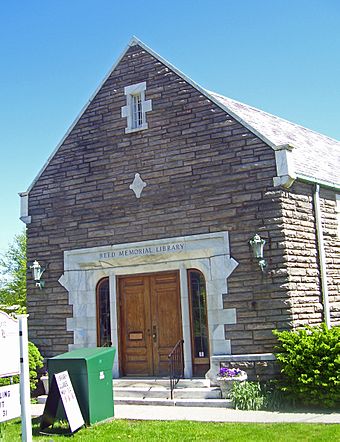Reed Memorial Library facts for kids
Quick facts for kids |
|
|
Reed Memorial Library
|
|

Front entrance of library, 2008
|
|
| Location | Carmel, NY |
|---|---|
| Nearest city | Danbury, CT |
| Built | 1914 |
| Architect | Miller-Reed Construction Co., Gaylor & Pryor |
| Architectural style | Tudorbethan |
| NRHP reference No. | 80002749 |
| Added to NRHP | 1980 |
The Reed Memorial Library is a special building in Carmel, New York. You can find it where two main roads, US 6 and NY 52, meet. It's the oldest library building in Putnam County. Because of its history and unique look, it was added to the National Register of Historic Places in 1980.
This library was built in 1914 by a woman named Arietta Crane Reed. She wanted to honor her late husband, William Belden Reed. He was a big supporter of the Literary Union of Carmel, which is the group that still runs the library today. The building has a cool Tudorbethan style. It's made from local stone and has fancy marble details. Inside, you can still see many of the original furniture pieces from when it first opened!
Contents
What the Library Looks Like
The Reed Memorial Library sits on a corner lot. It has a unique shape, like a one-story trapezoid. The outside walls are made of rough rock. This stone was taken from a quarry near Lake Gilead. The roof is made of slate and has three pointed sections called gables.
The main entrance has two doors. They are surrounded by narrow windows and a special stone frame. When you walk in, you enter a small tiled area called a vestibule. Beyond that is an oval-shaped lobby. This lobby is covered in beautiful oak wood panels.
Inside the Library
A row of columns separates the lobby from the main reading rooms. These rooms are in the rounded part of the building at the back. The main reading room has a fireplace with a very interesting mantel. It's carved to look like monks' heads!
The children's reading room also has a fireplace. Its mantel is simpler, with a classic Gothic Revival style. The library's design mixes old-fashioned charm with practical spaces for reading and learning.
History of the Library
Carmel has had a library for a long time, even before this building existed. In 1868, the Carmel Library Association started. They had about 900 books. At first, these books were kept in a member's home. Later, they moved to a local church.
It was hard for people to use the books in these places. So, in 1881, the Literary Union of Carmel was formed. This group took over the library. They kept the books in homes and then on the second floor of an office building.
Building a New Home
By 1911, the library's collection was growing very quickly. It needed its own dedicated space. Two members of the community donated the land for a new building. Arietta Crane Reed then gave the money to build the library. She did this to remember her husband, William Belden Reed. He was an executive at a construction company in New York City.
The company Pryor & Gaylor from New York was hired to design the building. They wanted it to be more than just a library. It was also meant to be a place where the community could meet. The building's unusual shape helped it serve both purposes. Reed's husband's company did the main construction work. A local company handled the stone work.
Construction started in November 1913. Just seven months later, in June 1914, the building was finished and opened! The total cost was about $45,000. That would be worth a lot more money today. The library has stayed almost exactly the same since it was built. No major changes have been made.
Library Style and Design
The Reed Memorial Library is the only important Tudorbethan-style building in the Carmel area. This style looks a bit like old English Tudor houses. Inside, you can see some Gothic Revival touches, like the fireplace in the children's room.
However, most of the inside shows the strong influence of the Arts and Crafts style. This movement was popular at the same time. It focused on simpler designs and good craftsmanship. It was a different approach from the very fancy and decorated buildings of the later Victorian era. The library's design combines these different styles to create a unique and welcoming space.

